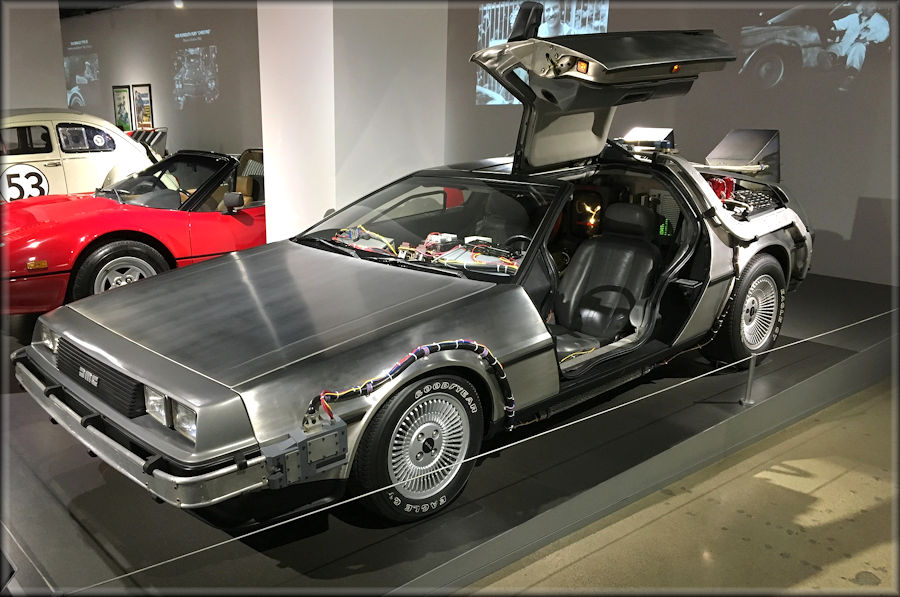

Mobile users:
For best results, view in Landscape mode.
1982 DeLorean DMC 12
( DeLorean Time Machine )

The 'Back to the Future' trilogy were
released in 1985, 1989 and 1990.
The DMC DeLorean aka the "DeLorean" is a sports car and
the only automobile manufactured by John DeLorean's
DeLorean Motor Company (DMC) for the American market
from 1981 to 1983.
There’s a reason the DMC-12 looked so unique and steely, and it’s
not a glamorous reason.
It’s because the car wasn’t painted. It rolled off the factory floor
with brushed stainless steel panels, which gave it a futuristic look.
In 1981, when Robert Zemeckis and Bob Gale first began to write
the "Back to the Future" script, they had a reconfigured refrigerator
as their time-traveling device.
When production for the film began in 1984, the refrigerator was
changed to a DeLorean.
The DeLorean had to reach 88 MPH to reach the speed required for
time travel.
The only problem was that the standard DeLorean's speedometer only
reached 85 MPH.
The production crew on the film had to build a custom speedometer
that went up to 95 mph, with a digital readout on top of the driver’s
side dashboard for accuracy.
Contrary to what Back to the Future would have you believe, the
DMC-12 wasn’t much of a sports car.
It was built with a 2.85-liter V6 engine based on the Renault
2.7-liter hatchback engine.
The DMC-12 only had 130 horsepower, and it took a whopping 8.8
seconds to reach 60 mph.
In the 'Back to the Future' trilogy, there were a total of about 7 cars
used in the films.
For filming purposes, the film's crew had 3 specialized DeLoreans
built.
The filmmakers replaced the V6 Powertrain motor with a Porsche
engine to help the car go faster.
Extra blinking lights and aircraft parts were also added to the
cars.
Along with the other changes to the DeLorean, the film added
a nuclear reactor to help the car "travel through time".
The base of this nuclear reactor was made with a
Dodge Polara's hubcap.
In the 1980's hit movie trilogy Back to the Future, 1.21 gigawatts
(pronounced jiggawatts in the films)
was the amount of electricity it took to power the flux capacitor
on the DeLorean time machine.
A gigawatt is equal to one billion watts.
The light bulbs in our homes are typically between 60 and
100 watts.
And 1.21 gigawatts would power more than 10 million light bulbs
or roughly equivalent to the power produced by 15 typical
commercial jet engines.
The film's producers characterized the DeLoreans with 3 names:
the A car, B car, and C car.
The "A" car, also known as the Hero car, was the most detailed
and utilized vehicle during production.
The "B" car - used for most of the driving scenes and fitted with
flamespitters near the wheels of the car, was destroyed during the
filming for Back to the Future Part III.
The "B" car, also known as Wreckage Car used in all three movies,
was mainly used for stunts.
After purposely being struck by a train during production, the
car was left as a pile of rubble.
Movie car customizer Jay Ohrberg used the "B" car wreckage to
construct various DeLorean replicas.
While the "A" and "B" cars were brought out of storage for the 2nd
and 3rd films, Universal ended up building another for Part II and
three more for Part III.
The "C" car was used for interior footage and was torn apart so the
camera could fit inside the car.
The vehicle was left at Universal Studios Hollywood, many of its
parts were put together on a replica remodeled by Tom Talmon
Studios for Universal Japan.
The fiberglass mock-up built for Part II, intended to be hung from
a crane for the flying car scenes, was destroyed by Universal
after filming.
And for Part III, Universal built the "Oxnard car," fitted with train
wheels for use in the rail scenes, along with 2 DeLoreans on
sand rail chassis and with Volkswagen engines and transaxles
for the off-road driving scenes.
The Oxnard car remains in Universal's possession and on display
at Universal Studios Florida.
Universal Studios have kept the original DeLorean DMC-12 from
Back to the Future for over 30 years.
They fully restored it and moved it to the Petersen Automotive
Museum in Los Angeles in April, 2016 where
it went on public display.
Even though getting your hands on an original Delorean
"Time Machine" is impossible, but replicas of the
three major versions (nuclear, Mr. Fusion, whitewall)
seem to be all over the place these days.
